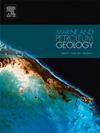Tectono-stratigraphic evolution of multiphase rifts in a hangingwall dip-slope setting: A case study in Eocene western slope, Xihu Sag of East China Sea Shelf Basin
IF 3.7
2区 地球科学
Q1 GEOSCIENCES, MULTIDISCIPLINARY
引用次数: 0
Abstract
The hangingwall dip-slope settings are important components of rift basins, being able to influence offshore sedimentation, but a few studies have examined their properties. Their reactivation of growth faults can contribute to re-shape basin geometry influencing the associated stratigraphic successions. This paper investigates the structural evolution of a hangingwall dip-slope setting to explore the development of multiphase rifts that imprint tectonic properties and stress field migration by utilizing seismic, well-log, and core data from the Xihu Sag, East China Sea Shelf Basin. Three composite sequences (CS1-3) are defined within the Eocene syn-rift deposits, along with three third-order sequences in CS3. We have reconstructed the evolution of two tectonic phases: rift phase 1 and rift phase 2. Furthermore, we identified two stages within each phase: rift initiation and rift development 1 for rift phase 1, and rift development 2 and rift termination for rift phase 2. However, an immediate decrease in fault activity was recorded in the rift phase 2. Alterations in the stress field throughout intermittent rift phases led to differences in tectono-stratigraphic structures. In rift phase 1, expansion occurred from small isolated depocenters to larger systems, while rift phase 2 experienced contraction. Concurrently, basin geometry evolved from wedge-shaped half-grabens to dish-like geometries. The tectonic change caused sediment overfilling to starvation in rift phase 1 and sediment starvation to balance filling in rift phase 2. This contribution provides insights into hangingwall dip-slope dynamics and rift basin depositional systems.
上盘倾斜环境下多相裂谷的构造地层演化——以东海陆架盆地西湖凹陷始新统西坡为例
上盘倾坡环境是裂谷盆地的重要组成部分,能够影响近海沉积,但对其性质的研究较少。它们对生长断裂的重新激活有助于重塑盆地的几何形状,影响相应的地层序列。利用东海陆架盆地西湖凹陷的地震、测井和岩心资料,研究了上盘倾斜背景下的构造演化,探讨了多相裂谷的发育特征和应力场迁移特征。在始新统同裂谷沉积中,确定了3个复合层序(cs1 ~ 3)和3个三级层序(CS3)。重建了裂谷一期和裂谷二期两个构造阶段的演化过程。此外,我们确定了每个阶段中的两个阶段:裂谷阶段1的裂谷起始和裂谷发育阶段,以及裂谷阶段2的裂谷发育阶段和裂谷终止阶段。然而,在裂谷第2阶段,断层活动立即减少。断续裂谷期应力场的变化导致构造地层结构的差异。在裂谷第一阶段,从小的孤立沉积中心向大的体系扩张,而裂谷第二阶段则经历收缩。与此同时,盆地的几何形状从楔形的半地堑演变为碟状的几何形状。构造变化导致裂谷一期泥沙过充到缺填,裂谷二期泥沙缺填到平衡填。这一贡献为上壁倾坡动力学和裂谷盆地沉积体系的研究提供了新的视角。
本文章由计算机程序翻译,如有差异,请以英文原文为准。
求助全文
约1分钟内获得全文
求助全文
来源期刊

Marine and Petroleum Geology
地学-地球科学综合
CiteScore
8.80
自引率
14.30%
发文量
475
审稿时长
63 days
期刊介绍:
Marine and Petroleum Geology is the pre-eminent international forum for the exchange of multidisciplinary concepts, interpretations and techniques for all concerned with marine and petroleum geology in industry, government and academia. Rapid bimonthly publication allows early communications of papers or short communications to the geoscience community.
Marine and Petroleum Geology is essential reading for geologists, geophysicists and explorationists in industry, government and academia working in the following areas: marine geology; basin analysis and evaluation; organic geochemistry; reserve/resource estimation; seismic stratigraphy; thermal models of basic evolution; sedimentary geology; continental margins; geophysical interpretation; structural geology/tectonics; formation evaluation techniques; well logging.
 求助内容:
求助内容: 应助结果提醒方式:
应助结果提醒方式:


